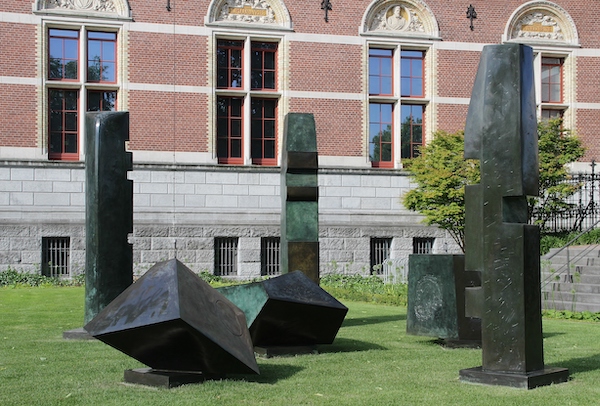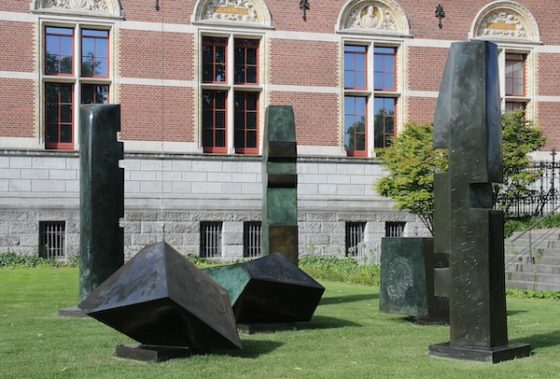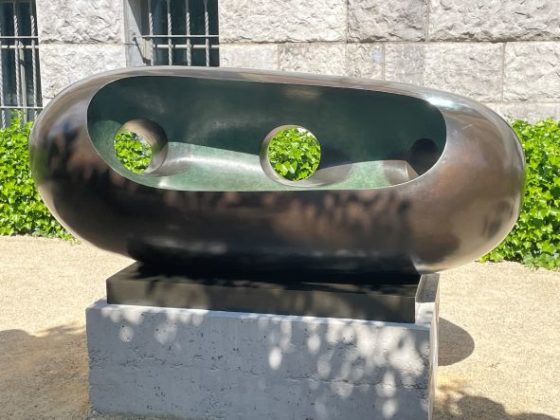Barbara Hepworth sculpture exhibition opens in Rijksmuseum gardens


A shiny green ‘rock’ of bronze, reflecting the light of the sun, crouches waiting to be filled with rainwater. A few steps away, three huge, abstract figures encircle three ‘magic stones’.
Nine sculptures by the 20th century British modernist artist Barbara Hepworth stand in the open gardens of the Rijksmuseum – with the prestigious building, neoclassical sculptures and the odd bird looking impassively on.
Sculptures on loan from English public gardens, parks, museums and private collections, including two listed works, have been united in the Rijksmuseum Gardens for a free, outdoor exhibition this summer.
Rijksmuseum general director Taco Dibbits said that Hepworth’s friendship with Dutch artist Piet Mondrian and her early exposure at the Kröller-Müller and Stedelijk Museums made her work especially appropriate for its ninth summer garden exhibition.
‘Barbara Hepworth once said no wonder that people are afraid of sculpture: sculptures have been caged in galleries,’ he said. ‘Here, with the sculptures outside, they are free – and what sculptures they are! Freed of the spaces that they often stand in, in museums, [and now here in] nature, an incredibly important force for Barbara Hepworth.’

Optimism
Sophie Bowness, guest curator, British art historian and the granddaughter of Hepworth, said that it was a ‘wonderful opportunity’ to show a representative group of major works, including Construction (Crucifixion), which refers to Mondrian’s style, and Hepworth’s ‘ambitious and radical’ The Family of Man group, made shortly before her death in 1975. Some of the work, said Bowness, had never before left England.
Stephen Feeke, a Hepworth expert at the Courtauld Institute of Art, said that some of the statues had been specially restored to refresh the special ‘patina’ coatings that Hepworth created for bronze statues, giving them a deep green or white appearance. The artist, who started working carving in wood, created much larger sculptures by making bronzes and used an unconventional technique: she would cover sheet metal in plaster and then carve and chisel shapes into it, ready to be cast and then finished.
Freeke said that she was a maker who ‘saw’ the completed image in the particular piece of material with which she was working, and was inspired by the natural world around her as well as a broad sense of spiritualism and optimism.
Looking down
‘Hepworth strongly believed in the affirmative power of art, a theme in many of the works here,’ he said. ‘Her work emanates from an instinctive, intuitive philosophy of making, often with no need for models or even preparatory sketches: the completed image of the work occupied her subconscious mind. Bronze allowed her to work on a greater scale than previously possible, a significant moment of creative risk that resulted in some of her most compelling and ambitious works, many of which have been included here.’
The sculptures in the garden include Hepworth’s characteristic ‘piercing’ holes, textured and polished surfaces that react to the weather and light, and abstract forms representing both particular people – including the son she lost in a 1953 plane crash – and humanity in general.
As a blackbird perched upon the head of a 19th century sculture cocked a curious eye, Bowness said her famously fastidious grandmother would have approved of her first solo Amsterdam exhibition. ‘She is looking down,’ she said, ‘with pleasure.’
The exhibition runs from June 3 until October 23
Thank you for donating to DutchNews.nl.
We could not provide the Dutch News service, and keep it free of charge, without the generous support of our readers. Your donations allow us to report on issues you tell us matter, and provide you with a summary of the most important Dutch news each day.
Make a donation